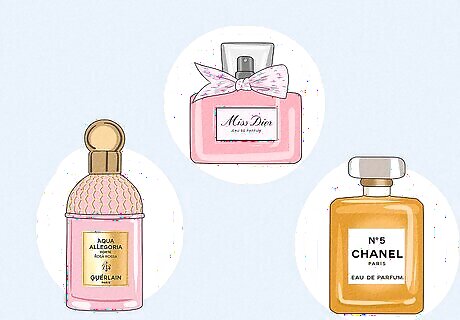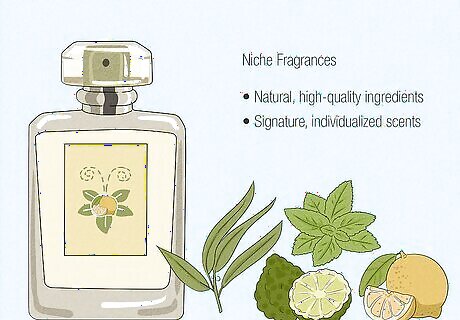
views
What is a niche fragrance?

A niche fragrance is a unique, in-house perfume made in small, limited batches. Sometimes called artisan or boutique fragrances, niche perfumes are produced only in small batches and usually only sold by the brand rather than other department stores and online retailers. As an alternative to mass perfume production, these niche fragrances often have unique and distinct scents that are hand-crafted and only produced in a limited range. Niche fragrances are known to value creativity, originality, and self-expression over mass-marketability or adherence to common trends. Niche perfumes also stay away from mass advertising through television, magazines, commercials, and celebrity endorsements. Although niche fragrance companies are smaller than major fragrance firms, they are still larger than “indie” perfume lines, which are typically owned and operated by the perfumers themselves.

Niche fragrances gained popularity during the turn of the 21st century. Although niche perfumes are meant to be smaller and more difficult to find than designer perfumes, this line has become continuously more blurred since the 2010s. Throughout the 2010s, the consumer desire for mass market fragrances declined, and the following for niche fragrances grew, leading large fragrance companies and corporations to purchase smaller niche lines and put them into wider distribution. For example, the Estée Lauder Companies bought Jo Malone London (a niche perfume line) in 1999 and marketed it as a designer perfume brand. These changes have complicated the idea of ‘niche’ perfumery since once ‘niche’ and limited perfumes have now been marketed to the masses and sold in department stores alongside designer fragrances. The division between niche and designer fragrances largely started in the 1970s and ‘80s, after L’Artisan Parfumeur—widely considered to be the first niche fragrance firm—opened in 1976 and the designer fragrance market became increasingly homogenized throughout the 1980s.
What is a designer perfume?

Designer perfumes are mass-produced fragrances from luxury companies. Designer fragrances are the type of perfumes that you would see in duty-free, department stores, or drug stores like CVS, Macy’s, Boots, and John Lewis. These perfumes often come from huge global companies and fashion houses like Dior, Guerlain, and Chanel. Designer perfumes are typically marketed as luxury fragrances with a high price point (although price may vary). They’re often endorsed by celebrities and heavily advertised on TV and in magazines. They’re also mass-produced and designed to be liked by a wide audience. This distinction is a key part of what sets designer perfumes apart from niche fragrances, which are released in limited batches for a smaller consumer base. Designer fragrances can sometimes include or be similar to celebrity fragrances, which are widely available and designed for mass-likability. Masstige fragrances (“mass” + “prestige”), on the other hand, are distinct in that they have a much lower price point but are designed to look and smell like a famous designer brand. Often referred to as “dupes,” these masstige fragrances may sacrifice quality to achieve a lower price.
Niche Perfume vs. Designer: Which Is Best?

Niche Perfumes: Pros & Cons Niche perfumes are thought to be of a higher quality than designer perfumes. Since niche perfumes are typically hand-blended by artisan perfumers in small batches, they’re more often made according to strict industry standards with natural, high-quality ingredients. In general, this type of manufacturing makes it less likely for a niche perfume to contain skin irritants or sub-standard ingredients. Plus, niche perfumes are unique and not mass-marketed; they’re produced in small quantities and have a wider range of varied and interesting scents. So, they’re great for fragrance lovers who want a signature, individualized scent that not everyone else will have! However, niche perfumes can be harder to find due to their exclusivity. They can’t be found at the closest drugstore or department store. And, depending on the niche perfume in question, they can come at a higher price point—but that price point is generally higher due to a higher standard of ingredients and craftsmanship.

Designer Perfumes: Pros & Cons Designer perfumes can be more affordable and easier to find than niche perfumes since they’re made for mass sales and have a wider audience than niche perfumes. However, mass production means that these fragrances are typically made by machine and completely homogenized, meaning they may lack the depth of scent or complexity of notes offered by niche perfumes. Designer perfumes must meet the demands of global perfume houses and large conglomerates. In order to please company shareholders and meet profit margins, these fragrances are often made with synthetic products and limit themselves to standardized, generic scents that have mass appeal. In addition, since designer scents are considered high-end and fashionable by many people, consumers also run the risk of accidentally buying counterfeit designer perfumes, which can be both dangerous and disappointing.

Key Takeaways When deciding between niche and designer fragrances, the right choice may look different for each person—which is why it’s important to weigh the pros and cons. Niche and designer fragrances both have their own time, place, and purpose: If someone is just getting into perfumes, a designer fragrance may be a good entry point before moving on to a luxury niche fragrance. If someone wants their own signature scent, a niche fragrance is more likely to offer an individualized and unique scent. If someone is buying a low-cost gift or temporary scent for a vacation, a cheaper designer perfume may do a good enough job. If someone is buying a nice gift for themselves or a friend, a special and high-quality niche fragrance may be more appropriate.
High-Quality Niche Perfumes

It’s hard to know which niche fragrances to try out first since each one is so unique and more under-the-radar than trendy designer scents. To help you get started, we rounded up 10 artisan-made niche fragrances sold by Smallflower that you should know about. Smallflower carries a curated selection of hundreds of niche fragrances. It’s a great place to explore niche perfume at every price point. Try one of the niche fragrances on this list, and hopefully find your signature scent! Kerosene Followed Eau de Parfum: Notes of cocoa, coffee, maple, and vanilla. Clue Perfumery With the Candlestick Eau de Parfum: Notes of cinnamon, labdanum, and musk. Stora Skuggan Moonmilk Eau De Parfum: Notes of black tea, lily of the valley, and sandalwood. Cathusia Mediterraneo Eau De Parfum: Notes of mint, lemon, eucalyptus, and bergamot. Mad Et Len Graphite Eau De Parfum: Notes of graphite, chalk, and wood. Summer Hours New Wave Eau de Parfum: Notes of jasmine, lemon, oceanic musk, and sea salt. Tauer Perfumes Golestan Eau de Parfum: Notes of cinnamon, rose, lemon, and patchouli. Vilhelm Parfumerie Poets of Berlin Eau de Parfum: Notes of blueberry, lemon, sandalwood, and vanilla. Maison Matine Bain de Midi Eau de Parfum: Notes of coconut, gardenia, musk, and vanilla. Amouage Guidance Eau de Parfum: Notes of ambergris, pear, rose, and vanilla.
How to Choose Your Niche Fragrance

Decide how strong you’d like your perfume concentration to be. Concentration refers to the percentage of perfume oil found in a fragrance. Fragrances with higher concentrations contain less alcohol, last longer and have a more powerful sillage, or scent trail. Some people like just a hint of fragrance on their skin, while some people want their signature scent to fill up any space that they enter. Start by familiarizing yourself with the different concentrations of perfume (described below). Once you decide what level of aroma you want in a perfume, look for that concentration as you shop for your niche fragrance. Extrait De Parfum: The strongest scent concentration at 20-34%. Eau de Parfum (EDP): 15-20%. Eau de Toilette (EDT): 5-15%. Eau de Cologne (EDC): 2-4%. Eau Fraîche: The most subtle scent concentration at 1-3%.

Narrow down what scents and scent families you like. The most important part of choosing your signature perfume is figuring out what type of scent appeals to and suits you—trends aside. Take an online scent quiz or review the different olfactory fragrance families and consider which one you’re most drawn to. Fragrances can smell completely different from person to person based on your unique skin chemistry. Some of the most common scent families include floral (rose, jasmine, violet), fresh (aquatic, citrus, ocean breeze, bergamot), woody (cedar, pine, rosemary), and warm (clove, tobacco, amber). If you’re totally unsure of what scents you like, order a niche perfume set and try a new perfume each day to get a feel for your favorite fragrances. Or, if you think you know what you like but aren’t ready to commit to a whole bottle, order a niche fragrance sample to use before purchasing the full-size perfume. You can also visit a department store or beauty store like Sephora, which will let you try on different perfumes and help you narrow down your favorite scents. Smallflower offers complimentary samples of the same niche fragrance with any full-sized bottle purchased at a value of $95 or more. They recommend that you use this sample first before opening the perfume so that you can easily return the fragrance and try a new one if you don’t love it.

Keep an open mind to appreciate uncommon pairings. Remember that part of the reason niche fragrances are so special is that they blend unique and complex scents together. High-quality niche perfumes will have different layers of notes that you may not ever see in other perfumes, meaning that you might not be used to them! So, take the time to get to know each scent you’re considering and keep an open mind to appreciate its individual complexities and aromas.

Spray on a fragrance and let it sit before making a decision. Niche perfumes can sometimes take a while to reveal the full extent of their complex underlying notes. Apply the fragrance onto your wrist and let the warmth of your skin activate and develop the scent for 5-10 minutes. Then, take a nice whiff to get the clearest sense of what the perfume will smell like on you. If you really want to indulge yourself, you can always choose more than one niche fragrance to have in your collection. Maybe you want a scent for every season (like florals for spring and earthy cedars for autumn) or just for every mood (try flirty cherry for date night and sophisticated linen for business meetings).




















Comments
0 comment